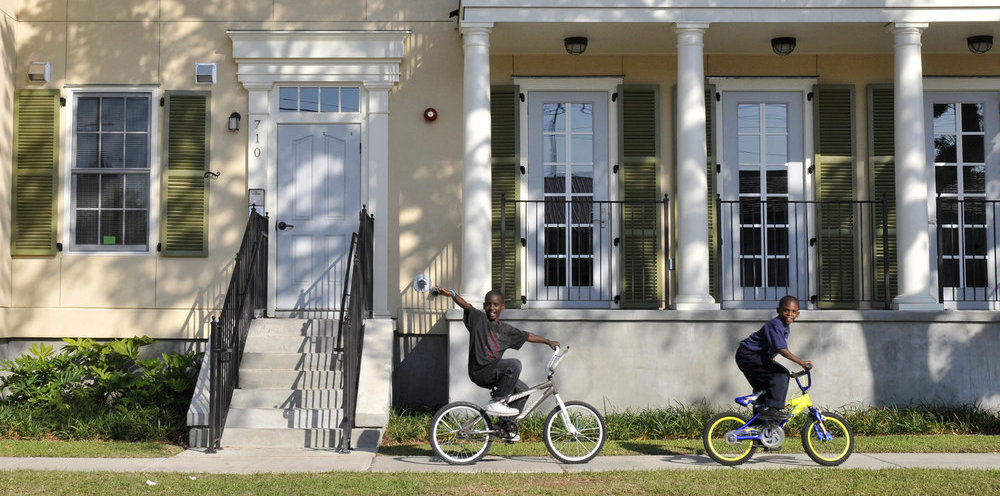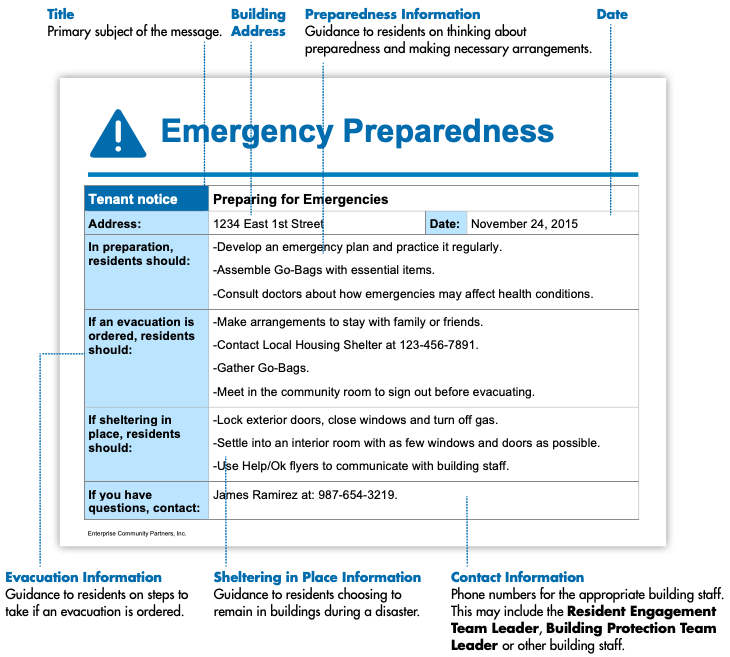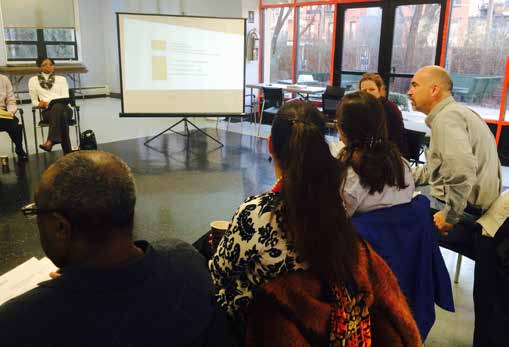What is the Business Continuity Toolkit and how can it support your disaster planning efforts?
The Ready to Respond: Business Continuity Toolkit is based on the Incident Command System (ICS), a planning framework used by federal, state and local first-responder agencies to help structure command, control and coordination of emergency response.
In Enterprise’s work with affordable housing partners recovering from Superstorm Sandy, these priorities were identified as essential to disaster preparedness:
| Minimize damage and ensure a quick return to service. | Support the safety, preparedness and recovery of residents. | Maintain key business operations throughout a disaster. |
By modeling a staffing plan on this standard, housing organizations draw on best practices and align their protocols and response timelines with key public agencies, while sharing a common language to describe preparedness efforts.
The ICS model lays out staff roles and responsibilities and the disaster-related protocols and systems needed to support an effective emergency response. By following the modules in this Toolkit, housing organizations will establish the following concepts and capabilities:
In the Disaster Staffing Toolkit, a disaster event is played out over eight operational periods, during which meetings are held and important tasks are completed by each Disaster Response Role.


With a Disaster Staffing Plan in place, your organization will know what actions to take 96 hours ahead of a predicted disaster, such as a storm, and immediately after a sudden disaster, for example an earthquake. By establishing these operational periods, organizations can be prepared to respond to both predicted and sudden disasters.

1 Get Oriented
Become familiar with the Toolkit materials so you can best help staff, while you manage the planning process effectively. Though you will be viewing many of these materials throughout the planning process, this is an important first look.
Watch the introduction video:
Watch these additional videos:
Read the following Job Action Packets including Job Descriptions, Job Action Sheets and tools:
- You will be managing the entire planning process for your organization. An essential part is communication—making sure staff has the information it needs so planning stays on schedule.
- Ask your organization’s Executive Director/CEO to send an announcement to staff about the disaster planning process and your assignment as EPC.
- Create a timeline for completing the four Modules in outlined in this User Guide.
- Provide progress reports to organizational leadership at agreed-upon intervals.
- Provide planning updates to staff and answer questions as needed.
2 Assign Disaster Response Roles
Work with senior staff to review the qualifications and responsibilities of each Disaster Response Role and choose the best person to fill it.
Coordinate a Senior Staff Meeting
- Work with the Executive Director/CEO to determine which senior staff members should be involved in identifying the best person to fill each Disaster Response Role.
- Prior to the meeting, provide senior staff with a meeting agenda, objectives, the Materials to Review included in this Module, and other Toolkit materials as needed.
Customize your Staffing Chart
- Begin the Senior Staff Meeting by viewing the video, Ready to Respond: An Overview of the Disaster Staffing Toolkit.
- As a group, review the Staffing Chart and Job Descriptions which describe the functions and qualifications for each role.
- Discuss how to best assign staff considering the size, functions and priorities of your organization.
- Fill in the names and contact information for the staff members chosen in the Staffing Chart.
Customize Job Action Packets
Job Action Packets are the bulk of your Disaster Staffing Plan. Work with your staff members so they completely customize the Job Action Sheets and Tools to fit the needs of your organization.
Understand how to Read a Job Action Sheet
A Job Action Sheet includes tasks to be completed over eight Operational Periods before, during and after a disaster.

Coordinate a Staff Meeting
- Provide staff members with the appropriate Job Action Packets and links to videos to review as they prepare for the meeting.
- Begin the meeting by viewing the Ready to Respond: An Overview of the Disaster Staffing Toolkit video.
- As a group, review the Staffing Chart. Have each staff member describe their role to the group.
- Ask staff to review their remaining Job Action Packet materials and answer questions as needed.
- Instruct staff to customize the materials in their Job Action Packets by a deadline (this deadline should be decided on before you host the Tabletop Exercise. Explain that customizing a Job Action Packet includes filling in the appropriate checklists, worksheets, Job Action Sheets and other materials to consider the specific needs and circumstances of your organization and each role.
- Emphasize which roles work together and that staff filling those roles should closely coordinate with collegues as they customize the roles.
Tip: You may want to meet with each staff member during the customizing process to review progress and ensure Job Action Sheets and tools are being completed properly.
3 Hold Tabletop Exercise
The Tabletop Exercise is a training session which tests your organization’s ability to respond to a disaster. It includes a simulated disaster scenario so staff members can practice their Job Action Packet tasks and practice communication between roles.
For more information, templates, and resources on holding Tabletop Exercises, see the Practice Your Response section.
Plan the Tabletop Exercise
- Set a date for the Tabletop, then send out invitations and agendas, secure space and gather the materials you’ll need.
- Remind participants to bring their Job Action Packets to the Tabletop Exercise. These will guide them and help them make any necessary changes.
- Customize the Tabletop Exercise Presentation. The severe weather scenario included in the presentation is a hurricane. You may choose a different scenario more likely to occur in your area. Customize the Staffing Chart, Agenda and other items in the presentation as you see fit.
Tip: If you do not feel comfortable being responsible for the Tabletop Exercise, recruit another staff member or an outside facilitator experienced in guiding discussion and keeping a group on task.
Conduct the Tabletop Exercise
- Welcome participants and review the purpose of the Tabletop Exercise.
- Present the information in the Tabletop Exercise Presentation.
- At the end of each Operational Period in the presentation, instruct participants to break into discussion groups.
- For more details, see the Tabletop Facilitator Guide.
Complete the Evaluation and After Action Report
- After the Tabletop Exercise Presentation, ask participants to complete the Tabletop Evaluation Form answering questions about the strengths and weaknesses of the exercise and how it might be improved.
- Write the After Action Report (AAR). The AAR provides an explanation of what happened during the Tabletop Exercise and an evaluation of staff performance and the effectiveness of your organization’s Disaster Staffing Plan.
Ongoing Maintenance
Continually practicing and refining your Disaster Staffing Plan is essential to ensuring its effectiveness. As your organization changes, and potential threats to your buildings and residents change, be sure to perform these important tasks to keep your plan up-to-date.
Hold regular Tabletop Exercises
- Conduct Tabletop Exercises or similar trainings regularly to continually practice your preparedness plans and skills.
- Use different scenarios for each exercise to prepare for a variety of disasters.
Incorporate After Action Reports
- Write an After Action Report after every Tabletop Exercise and any actual disaster to identify necessary revisions to your Disaster Staffing Plan.
- Coordinate with staff on revisions to individual Job Action Packets.
Reassign Roles as Staff Change
- As staff members move locations or take on different jobs within your organization, be sure to reassign staff to Disaster Response Roles as needed.
- When staff leave your organization, be sure to assign new staff to fill each Disaster Response Role.
Update Materials Regularly
- Coordinate with staff to keep updated versions of customized Job Action Packets.
- Carefully oversee all planning materials and be sure staff know where they can be found.


